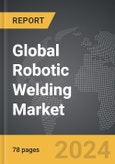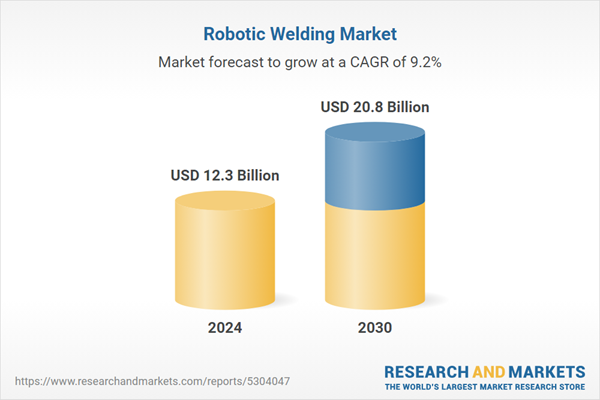The global market for Robotic Welding was valued at US$12.3 Billion in 2024 and is projected to reach US$20.8 Billion by 2030, growing at a CAGR of 9.2% from 2024 to 2030. This comprehensive report provides an in-depth analysis of market trends, drivers, and forecasts, helping you make informed business decisions. The report includes the most recent global tariff developments and how they impact the Robotic Welding market.
Segments: Type (Spot Welding, Arc Welding, Other Types); End-Use (Automotive & Transportation, Electricals & Electronics, Aerospace & Defense, Metals & Machinery, Other End-Uses).
Geographic Regions/Countries: World; United States; Canada; Japan; China; Europe (France; Germany; Italy; United Kingdom; and Rest of Europe); Asia-Pacific; Rest of World.
The analysts continuously track trade developments worldwide, drawing insights from leading global economists and over 200 industry and policy institutions, including think tanks, trade organizations, and national economic advisory bodies. This intelligence is integrated into forecasting models to provide timely, data-driven analysis of emerging risks and opportunities.
Global Robotic Welding Market - Key Trends and Drivers Summarized
How Is Robotic Welding Revolutionizing Industrial Manufacturing?
Robotic welding is a widely used automation process in manufacturing, where robots are programmed to perform welding tasks with precision and consistency. It plays a crucial role in industries such as automotive, aerospace, and construction, where high-volume production and quality are critical. Robotic welding involves the use of robotic arms, sensors, and controllers to execute tasks like arc welding, spot welding, and laser welding. By automating the welding process, manufacturers can achieve increased productivity, improved quality, and reduced human error. As industries push for higher efficiency, robotic welding has become indispensable for meeting the demands of modern production lines.What Are the Key Segments in the Robotic Welding Market?
Key types include arc welding, spot welding, laser welding, and TIG (tungsten inert gas) welding. Arc welding is widely used due to its versatility and ability to handle a range of metals and thicknesses, making it ideal for the automotive and metalworking industries. Spot welding is commonly applied in high-speed production environments, such as automotive assembly lines, where metal sheets need to be joined quickly and securely. Laser welding, though less common, is gaining traction for its precision and minimal heat distortion, which is advantageous in electronics and aerospace manufacturing. Applications of robotic welding include automotive, metal fabrication, construction, and aerospace. The automotive industry represents the largest segment, where robotic welding is integral to the assembly of vehicle components, ensuring consistent weld quality and high production rates. Metal fabrication and construction sectors also employ robotic welding for structural assemblies, enhancing the durability and reliability of the final products. Aerospace relies on robotic welding for precise fabrication of aircraft parts, as the stringent quality requirements in aerospace necessitate flawless welding quality. In electronics, robotic welding supports miniaturization and precision in product assembly, further broadening the market.How Is Robotic Welding Applied Across Various Manufacturing Sectors?
In the automotive industry, robotic welding is used for tasks such as chassis assembly, component welding, and body panel joining, improving production speed and product uniformity. Metal fabrication employs robotic welders to handle heavy-duty structural components, ensuring reliable joints for infrastructure and construction applications. In aerospace, robotic welding offers the precision needed to manufacture lightweight, durable components with minimal thermal distortion, contributing to overall aircraft safety and efficiency. In the electronics sector, robotic welding supports delicate and precise assemblies, where manual welding would be too challenging or time-consuming. These diverse applications demonstrate the adaptability of robotic welding across manufacturing.What Factors Are Driving the Growth in the Robotic Welding Market?
The growth in the Robotic Welding market is driven by several factors, including the push for automation in manufacturing, advancements in welding technologies, and the need for high-quality production. Innovations like AI-driven programming, improved sensors, and adaptive welding technology have enhanced the capabilities of robotic welders, making them more versatile and user-friendly. The focus on increasing production efficiency, maintaining high-quality standards, and reducing labor costs has further fueled demand, as robotic welding provides a reliable solution for consistent, high-speed welding. Additionally, the expansion of automotive manufacturing, rising metal fabrication, and increased use of lightweight materials have contributed to market growth, supporting the broader adoption of robotic welding systems across various industries.Report Scope
The report analyzes the Robotic Welding market, presented in terms of units. The analysis covers the key segments and geographic regions outlined below.Segments: Type (Spot Welding, Arc Welding, Other Types); End-Use (Automotive & Transportation, Electricals & Electronics, Aerospace & Defense, Metals & Machinery, Other End-Uses).
Geographic Regions/Countries: World; United States; Canada; Japan; China; Europe (France; Germany; Italy; United Kingdom; and Rest of Europe); Asia-Pacific; Rest of World.
Key Insights:
- Market Growth: Understand the significant growth trajectory of the Spot Welding segment, which is expected to reach US$12.3 Billion by 2030 with a CAGR of a 8.6%. The Arc Welding segment is also set to grow at 9.4% CAGR over the analysis period.
- Regional Analysis: Gain insights into the U.S. market, valued at $3.4 Billion in 2024, and China, forecasted to grow at an impressive 8.6% CAGR to reach $3.2 Billion by 2030. Discover growth trends in other key regions, including Japan, Canada, Germany, and the Asia-Pacific.
Why You Should Buy This Report:
- Detailed Market Analysis: Access a thorough analysis of the Global Robotic Welding Market, covering all major geographic regions and market segments.
- Competitive Insights: Get an overview of the competitive landscape, including the market presence of major players across different geographies.
- Future Trends and Drivers: Understand the key trends and drivers shaping the future of the Global Robotic Welding Market.
- Actionable Insights: Benefit from actionable insights that can help you identify new revenue opportunities and make strategic business decisions.
Key Questions Answered:
- How is the Global Robotic Welding Market expected to evolve by 2030?
- What are the main drivers and restraints affecting the market?
- Which market segments will grow the most over the forecast period?
- How will market shares for different regions and segments change by 2030?
- Who are the leading players in the market, and what are their prospects?
Report Features:
- Comprehensive Market Data: Independent analysis of annual sales and market forecasts in US$ Million from 2024 to 2030.
- In-Depth Regional Analysis: Detailed insights into key markets, including the U.S., China, Japan, Canada, Europe, Asia-Pacific, Latin America, Middle East, and Africa.
- Company Profiles: Coverage of players such as ABB, Carl Cloos Schweisstechnik GmbH, Comau S.P.A, Daihen Corporation, Denso Corporation and more.
- Complimentary Updates: Receive free report updates for one year to keep you informed of the latest market developments.
Some of the 11 companies featured in this Robotic Welding market report include:
- ABB
- Carl Cloos Schweisstechnik GmbH
- Comau S.P.A
- Daihen Corporation
- Denso Corporation
- FANUC Corporation
- IGM Robotic Systems
- Kawasaki Heavy Industries ltd.
- Kuka AG
- Nachi-Fujikoshi Corp
- Panasonic Corporation
- Yaskawa Electric Corporation
Tariff Impact Analysis: Key Insights for 2025
Global tariff negotiations across 180+ countries are reshaping supply chains, costs, and competitiveness. This report reflects the latest developments as of April 2025 and incorporates forward-looking insights into the market outlook.The analysts continuously track trade developments worldwide, drawing insights from leading global economists and over 200 industry and policy institutions, including think tanks, trade organizations, and national economic advisory bodies. This intelligence is integrated into forecasting models to provide timely, data-driven analysis of emerging risks and opportunities.
What’s Included in This Edition:
- Tariff-adjusted market forecasts by region and segment
- Analysis of cost and supply chain implications by sourcing and trade exposure
- Strategic insights into geographic shifts
Buyers receive a free July 2025 update with:
- Finalized tariff impacts and new trade agreement effects
- Updated projections reflecting global sourcing and cost shifts
- Expanded country-specific coverage across the industry
Table of Contents
I. METHODOLOGYII. EXECUTIVE SUMMARY2. FOCUS ON SELECT PLAYERSIII. MARKET ANALYSISIV. COMPETITION
1. MARKET OVERVIEW
3. MARKET TRENDS & DRIVERS
4. GLOBAL MARKET PERSPECTIVE
UNITED STATES
CANADA
JAPAN
CHINA
EUROPE
FRANCE
GERMANY
ITALY
UNITED KINGDOM
REST OF EUROPE
ASIA-PACIFIC
REST OF WORLD
Companies Mentioned (Partial List)
A selection of companies mentioned in this report includes, but is not limited to:
- ABB
- Carl Cloos Schweisstechnik GmbH
- Comau S.P.A
- Daihen Corporation
- Denso Corporation
- FANUC Corporation
- IGM Robotic Systems
- Kawasaki Heavy Industries ltd.
- Kuka AG
- Nachi-Fujikoshi Corp
- Panasonic Corporation
- Yaskawa Electric Corporation
Table Information
| Report Attribute | Details |
|---|---|
| No. of Pages | 78 |
| Published | April 2025 |
| Forecast Period | 2024 - 2030 |
| Estimated Market Value ( USD | $ 12.3 Billion |
| Forecasted Market Value ( USD | $ 20.8 Billion |
| Compound Annual Growth Rate | 9.2% |
| Regions Covered | Global |









